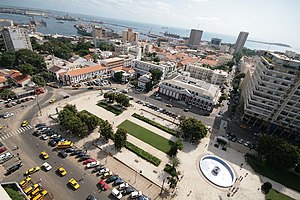 | |
Trade organisations | AU, AfCFTA, ECOWAS, CEN-SAD, WTO |
|---|---|
Country group |
|
| Statistics | |
| Population | |
| GDP | |
| GDP rank | |
GDP growth |
|
GDP per capita | |
GDP per capita rank | |
GDP by sector |
|
| 2.2% (2021)[4] | |
Population below poverty line | |
| 38.1 medium (2018, World Bank)[7] | |
Labour force | |
Labour force by occupation |
|
| Unemployment | 15,7% (2017)[12] |
Main industries | agricultural and fish processing, phosphate mining, fertilizer production, petroleum refining, zircon, and gold mining, construction materials, ship construction and repair |
| External | |
| Exports | |
Export goods | fish, groundnuts (peanuts), petroleum products, phosphates, cotton |
Main export partners |
|
| Imports | |
Import goods | food and beverages, capital goods, fuels |
Main import partners | |
Gross external debt | |
| Public finances | |
| −3.6% (of GDP) (2017 est.)[5] | |
| Revenues | 4.139 billion (2017 est.)[5] |
| Expenses | 4.9 billion (2017 est.)[5] |
All values, unless otherwise stated, are in US dollars. | |







The economy of Senegal is driven by mining, construction, tourism, fishing and agriculture, which are the main sources of employment in rural areas, despite abundant natural resources in iron, zircon, gas, gold, phosphates, and numerous oil discoveries recently. Senegal's economy gains most of its foreign exchange from fish, phosphates, groundnuts, tourism, and services. As one of the dominant parts of the economy, the agricultural sector of Senegal is highly vulnerable to environmental conditions, such as variations in rainfall and climate change, and changes in world commodity prices.
Dakar, the former capital of French West Africa, is also home to banks and other institutions which serve all of Francophone West Africa, and is a hub for shipping and transport in the region.
Senegal also has one of the best developed tourist industries in Africa. Senegal's economy depends on foreign assistance. It is a member of the World Trade Organization.
The main obstacles to the economic development of the country are its great corruption with inefficient justice, very slow administrative formalities, and a failing education sector.[13]
- ^ "World Economic Outlook Database, April 2019". IMF.org. International Monetary Fund. Retrieved 29 September 2019.
- ^ "World Bank Country and Lending Groups". datahelpdesk.worldbank.org. World Bank. Retrieved 29 September 2019.
- ^ "Population, total - Senegal". data.worldbank.org. World Bank. Retrieved 25 January 2020.
- ^ a b c d e f "World Economic Outlook Database, April 2024". IMF.org. International Monetary Fund. Retrieved 15 May 2024.
- ^ a b c d e f g h i j k l m n "The World Factbook". CIA.gov. Central Intelligence Agency. Retrieved 1 February 2019.
- ^ "Poverty headcount ratio at $3.20 a day (2011 PPP) (% of population) - Senegal". data.worldbank.org. World Bank. Retrieved 25 January 2020.
- ^ "GINI index (World Bank estimate)". data.worldbank.org. World Bank. Retrieved 18 March 2019.
- ^ "Human Development Index (HDI)". hdr.undp.org. HDRO (Human Development Report Office) United Nations Development Programme. Retrieved 17 November 2022.
- ^ "Inequality-adjusted Human Development Index (IHDI)". hdr.undp.org. HDRO (Human Development Report Office) United Nations Development Programme. Retrieved 17 November 2022.
- ^ "Labor force, total - Senegal". data.worldbank.org. World Bank. Retrieved 25 January 2020.
- ^ "Employment to population ratio, 15+, total (%) (national estimate) - Senegal". data.worldbank.org. World Bank. Retrieved 25 January 2020.
- ^ "Le taux de chômage est estimé à 15,7% (T4 2017)", 27 December 2019.
- ^ The Economist, The African Century, March 28th 2020.